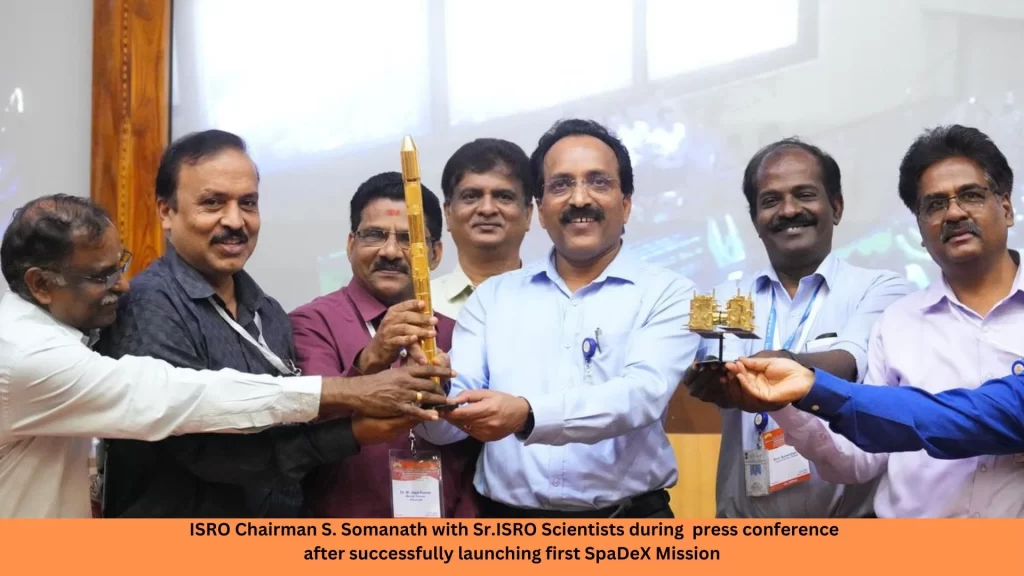India’s space journey reached an exciting milestone with the Indian Space Research Organisation (ISRO) successfully launching its first Space Docking Experiment (SpaDeX). The mission, a precursor to the ambitious Chandrayaan-4 lunar expedition, highlights ISRO’s dedication to mastering docking technology, a critical component for future space missions.
On December 30, 2024, the PSLV C60 mission carried two 220-kg satellites into orbit. These satellites, now positioned in a circular orbit 475 kilometers above Earth, are set to rendezvous and dock by January 7, 2025. This experiment demonstrates India’s capability to execute precise orbital maneuvers, laying the groundwork for Chandrayaan-4 and beyond.
SpaDeX marks a significant step forward in India’s space endeavors. During a press conference at Sriharikota, ISRO Chairman S. Somanath described the docking process as a meticulous operation where the two satellites will gradually close the 20-kilometer distance between them. This process, occurring at a breathtaking speed of 28,000 km/h, demands exceptional precision to align and connect the satellites seamlessly.
“Docking technology is vital for Chandrayaan-4 and future missions,” said Mr. Somanath. He emphasized that mastering this technology is essential for complex operations like assembling modules in space, transporting materials, and sustaining a long-term human presence in orbit.
Slated for launch in 2025, Chandrayaan-4 aims to bring lunar soil samples back to Earth. This ambitious mission will rely heavily on docking manoeuvres to achieve its goals. The mission involves four modules: the transfer, re-entry, descent, and ascent modules. These modules will be launched aboard two LVM-3 rockets, each carrying specific components of the mission.
Once in space, the transfer and re-entry modules will dock with the descent and ascent modules in geosynchronous transfer orbit. Together, they will journey to the lunar orbit. While the transfer and re-entry modules remain in orbit, the descent and ascent modules will descend to the Moon’s surface. A robotic scoop will then collect a 3-kg sample of lunar soil, sealing it in a cartridge for safe transport.
After completing its task, the ascent module will lift off from the Moon and dock with the transfer module, transferring the sample before being jettisoned. The re-entry module will then carry the sample back to Earth for scientific study.
Docking technology plays a pivotal role in the Chandrayaan-4 mission and India’s broader space aspirations. “You cannot launch everything in one go,” said Chandrayaan-4 Study Director P. Veeramuthuvel. “Docking is essential for assembling modules, enabling long-term missions, and ensuring a steady human presence in space.”
This expertise is also crucial for the planned Bharatiya Antariksh Station (BAS), expected to be operational by 2035. With five interconnected modules, BAS will rely on advanced docking capabilities for its assembly and functionality.
The SpaDeX mission is just the beginning of what promises to be a landmark year for ISRO. According to Mr. Somanath, 2025 will witness the launch of four Geosynchronous Satellite Launch Vehicles (GSLV), three Polar Satellite Launch Vehicles (PSLV), and a Small Satellite Launch Vehicle (SSLV). Among these launches, the 100th mission from Sriharikota will mark a significant milestone in India’s space history.
The challenges ahead are immense, but ISRO’s success with SpaDeX demonstrates its readiness to tackle complex space operations. “Docking is not easy,” noted former ISRO associate director B.R. Guruprasad. “You need to synchronize the speed and trajectory of the satellites with extreme precision.”
With SpaDeX successfully underway, ISRO is inching closer to realizing its ambitious goals. The Chandrayaan-4 mission, with its intricate sequence of docking and undocking maneuvers, will not only return lunar soil samples but also cement India’s position as a major player in space exploration.
As ISRO looks ahead to a year filled with groundbreaking missions, the successful completion of SpaDeX sets the stage for an exciting future in space exploration. Each mission brings India closer to its vision of sustainable space exploration and long-term human presence in space. With determination and innovation, ISRO is propelling India into a new era of space leadership.




